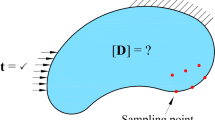Abstract
Based on reciprocity relations in material space, influence surfaces are established for the evaluation of the energy changes between interacting defects. In this way, the change of the driving force on a crack tip due to changes of the position, size and orientation of neighboring defects can be evaluated. The method enables to assess defect configurations in an elastic material in a straight-forward manner.











Similar content being viewed by others
References
Barber JR (2002) Elasticity, 2nd edn. Kluwer, Dordrecht
Budiansky B, Rice JR (1973) Conservation laws and energy-release rates. ASME J Appl Mech 40:201–203
Eshelby J (1951) A force on an elastic singularity. Philos Trans R Soc Lond A 244:87–112
Evans AG, Suo Z, Wang RZ, Aksay IA, He MY, Hutchinson JW (2001) Model for the robust mechanical behavior of nacre. J Mater Res 16:2475–2484
Gross D (1982) Spannungsintensitätsfaktoren von Rißsystemen. Ing Arch 51:301–310
Günther W (1962) Über einige Randintegrale der Elastomechanik. Abh Braunschw Wiss Ges 14:53–72
Gurtin ME (2000) Configurational forces as basic concepts of continuum physics. Springer, New York
Herrmann G, Kienzler R (2007) Reciprocity relations in Eshelbian mechanics. Mech Res Commmun 34:338–343
Herrmann G, Kienzler R (2008) A reciprocity relation couples Newtonian and Eshelbian mechanics. ASME J Appl Mech 75(011017):1–5
Hibbeler RC (2014) Structural analysis, 9th edn. Pearson Prentice Hall, Upper Saddle River
Kienzler R (2007) Reciprocity in fracture and defect mechanics. Int J Frac 147:3–11
Kienzler R, Herrmann G (2000) Mechanics in material space. Springer, Berlin
Kienzler R, Herrmann G (2008) Nonlinear and linearized reciprocity relations in structural configurational mechanics. Acta Mech 195:3–11
Knowles JK, Sternberg E (1972) On a class of conservation laws in linearized and finite elastostatics. Arch Ration Mech Anal 44:187–211
Krüger KH (1981) Die Randintegralmethode zur Lösung ebener Vielrißprobleme der linearen Elastostatik. PhD thesis, Tech Hochsch Darmstadt, Darmstadt, Germany
Lubarda VA (2011) Emission of dislocations from nanovoids under combined loading. Int J Plast 27:181–200
Marguerre K (1962) Elasticity, basic concepts. In: Flügge W (ed) Handbook of engineering mechanics. McGraw-Hill, New York
Maugin GA (1993) Material inhomogeneities in elasticity. Chapman & Hall, London
Maugin GA (2011) Configurational forces. Chapman & Hall/CRC, Boca Raton
Murck M (2013) Entwicklung von Keramik-Polymer-Schichtverbundwerkstoffen nach dem Vorbild des Perlmutts. PhD-thesis, University of Bremen, Bremen, Germany
Plate C, Müller R, Humbert A, Gross D (2012) Evaluation of the criticality of cracks in ice shelves using finite element simulations. The Cryosphere 6:973–984
Python Documentation 2.6.2 (2009) https://www.python.org/download/releases/2.6.2/
Rice JR (1968) A path independent integral and the approximate analysis of strain concentration by notches and cracks. ASME J Appl Mech 27:379–386
Rice JR, Thomson R (1974) Ductile versus brittle behavior of crystals. Philos Mag 29:73–97
Sih GC (1973) Handbook of stress intensity factors. Lehigh University, Bethlehem
Tada H, Paris PC, Irwin GR (1973) The stress analysis of cracks handbook. Del Research Corporation, Hellertown
Washizu K (1982) Variational methods in elasticity and plasticity. Pergamon, Oxford
Acknowledgments
The support by the German Science Foundation (Deutsche Forschungsgemeinschaft, DFG) under Grant KI 284-19/1 is gratefully acknowledged.
Author information
Authors and Affiliations
Corresponding author
Rights and permissions
About this article
Cite this article
Kienzler, R., Schröder, R. On influence surfaces in material space. Int J Fract 202, 207–215 (2016). https://doi.org/10.1007/s10704-016-0149-z
Received:
Accepted:
Published:
Issue Date:
DOI: https://doi.org/10.1007/s10704-016-0149-z




